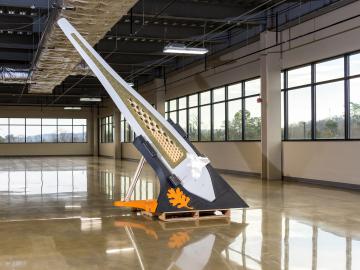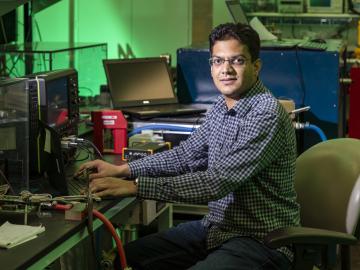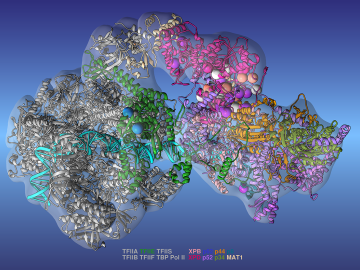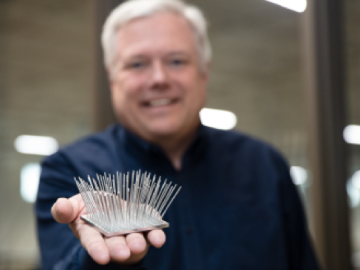
Filter News
Area of Research
- (-) Biology and Environment (36)
- (-) Energy Science (182)
- (-) Fusion Energy (11)
- (-) Supercomputing (76)
- Advanced Manufacturing (22)
- Building Technologies (1)
- Computational Biology (1)
- Computational Engineering (2)
- Computer Science (6)
- Electricity and Smart Grid (3)
- Fuel Cycle Science and Technology (1)
- Functional Materials for Energy (1)
- Fusion and Fission (30)
- Isotope Development and Production (1)
- Isotopes (27)
- Materials (67)
- Materials for Computing (11)
- National Security (29)
- Neutron Science (20)
- Nuclear Science and Technology (38)
- Nuclear Systems Modeling, Simulation and Validation (1)
- Quantum information Science (1)
- Sensors and Controls (2)
- Transportation Systems (2)
News Topics
- (-) 3-D Printing/Advanced Manufacturing (83)
- (-) Big Data (34)
- (-) Grid (42)
- (-) Isotopes (3)
- (-) Nuclear Energy (21)
- (-) Security (10)
- (-) Summit (48)
- (-) Transportation (71)
- Advanced Reactors (14)
- Artificial Intelligence (45)
- Bioenergy (66)
- Biology (82)
- Biomedical (32)
- Biotechnology (18)
- Buildings (39)
- Chemical Sciences (21)
- Clean Water (19)
- Composites (19)
- Computer Science (118)
- Coronavirus (31)
- Critical Materials (12)
- Cybersecurity (15)
- Energy Storage (75)
- Environment (147)
- Exascale Computing (29)
- Fossil Energy (2)
- Frontier (32)
- Fusion (17)
- High-Performance Computing (57)
- Hydropower (10)
- Machine Learning (25)
- Materials (50)
- Materials Science (45)
- Mathematics (7)
- Mercury (10)
- Microelectronics (1)
- Microscopy (20)
- Molten Salt (1)
- Nanotechnology (18)
- National Security (12)
- Neutron Science (23)
- Partnerships (13)
- Physics (9)
- Polymers (14)
- Quantum Computing (20)
- Quantum Science (26)
- Simulation (28)
- Software (1)
- Space Exploration (6)
- Statistics (1)
Media Contacts

A team of researchers at Oak Ridge National Laboratory have demonstrated that designed synthetic polymers can serve as a high-performance binding material for next-generation lithium-ion batteries.

In the shifting landscape of global manufacturing, American ingenuity is once again giving U.S companies an edge with radical productivity improvements as a result of advanced materials and robotic systems developed at the Department of Energy’s Manufacturing Demonstration Facility (MDF) at Oak Ridge National Laboratory.

Galigekere is principal investigator for the breakthrough work in fast, wireless charging of electric vehicles being performed at the National Transportation Research Center at Oak Ridge National Laboratory.

Environmental conditions, lifestyle choices, chemical exposure, and foodborne and airborne pathogens are among the external factors that can cause disease. In contrast, internal genetic factors can be responsible for the onset and progression of diseases ranging from degenerative neurological disorders to some cancers.

OAK RIDGE, Tenn., May 8, 2019—Oak Ridge National Laboratory and Lincoln Electric (NASDAQ: LECO) announced their continued collaboration on large-scale, robotic additive manufacturing technology at the Department of Energy’s Advanced Manufacturing InnovationXLab Summit.

Using Summit, the world’s most powerful supercomputer housed at Oak Ridge National Laboratory, a team led by Argonne National Laboratory ran three of the largest cosmological simulations known to date.

In a step toward advancing small modular nuclear reactor designs, scientists at Oak Ridge National Laboratory have run reactor simulations on ORNL supercomputer Summit with greater-than-expected computational efficiency.

When Scott Smith looks at a machine tool, he thinks not about what the powerful equipment used to shape metal can do – he’s imagining what it could do with the right added parts and strategies. As ORNL’s leader for a newly formed group, Machining and Machine Tool Research, Smith will have the opportunity to do just that.

Scientists at Oak Ridge National Laboratory have developed a low-cost, printed, flexible sensor that can wrap around power cables to precisely monitor electrical loads from household appliances to support grid operations.

Scientists at the Department of Energy’s Oak Ridge National Laboratory are working to understand both the complex nature of uranium and the various oxide forms it can take during processing steps that might occur throughout the nuclear fuel cycle.


